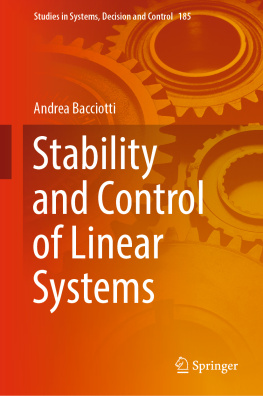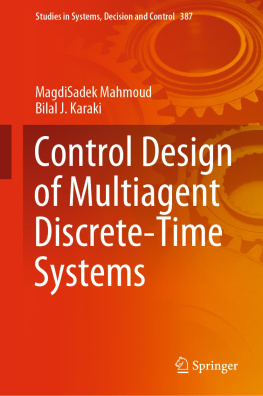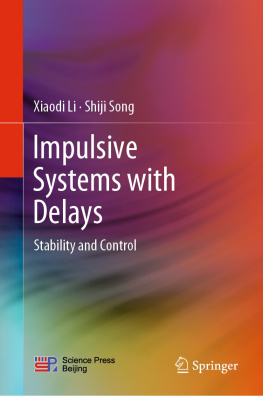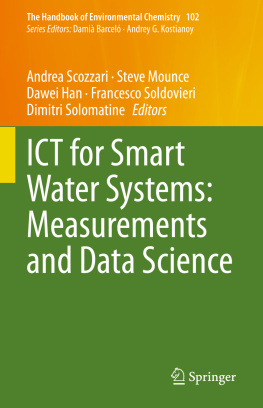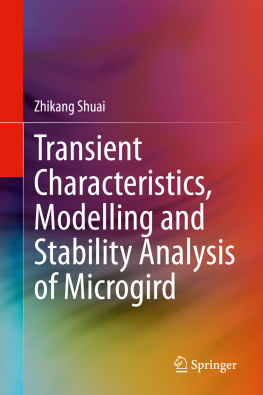Andrea Bacciotti - Stability and Control of Linear Systems
Here you can read online Andrea Bacciotti - Stability and Control of Linear Systems full text of the book (entire story) in english for free. Download pdf and epub, get meaning, cover and reviews about this ebook. year: 0, publisher: Springer International Publishing, genre: Computer. Description of the work, (preface) as well as reviews are available. Best literature library LitArk.com created for fans of good reading and offers a wide selection of genres:
Romance novel
Science fiction
Adventure
Detective
Science
History
Home and family
Prose
Art
Politics
Computer
Non-fiction
Religion
Business
Children
Humor
Choose a favorite category and find really read worthwhile books. Enjoy immersion in the world of imagination, feel the emotions of the characters or learn something new for yourself, make an fascinating discovery.
- Book:Stability and Control of Linear Systems
- Author:
- Publisher:Springer International Publishing
- Genre:
- Year:0
- Rating:3 / 5
- Favourites:Add to favourites
- Your mark:
- 60
- 1
- 2
- 3
- 4
- 5
Stability and Control of Linear Systems: summary, description and annotation
We offer to read an annotation, description, summary or preface (depends on what the author of the book "Stability and Control of Linear Systems" wrote himself). If you haven't found the necessary information about the book — write in the comments, we will try to find it.
Stability and Control of Linear Systems — read online for free the complete book (whole text) full work
Below is the text of the book, divided by pages. System saving the place of the last page read, allows you to conveniently read the book "Stability and Control of Linear Systems" online for free, without having to search again every time where you left off. Put a bookmark, and you can go to the page where you finished reading at any time.
Font size:
Interval:
Bookmark:
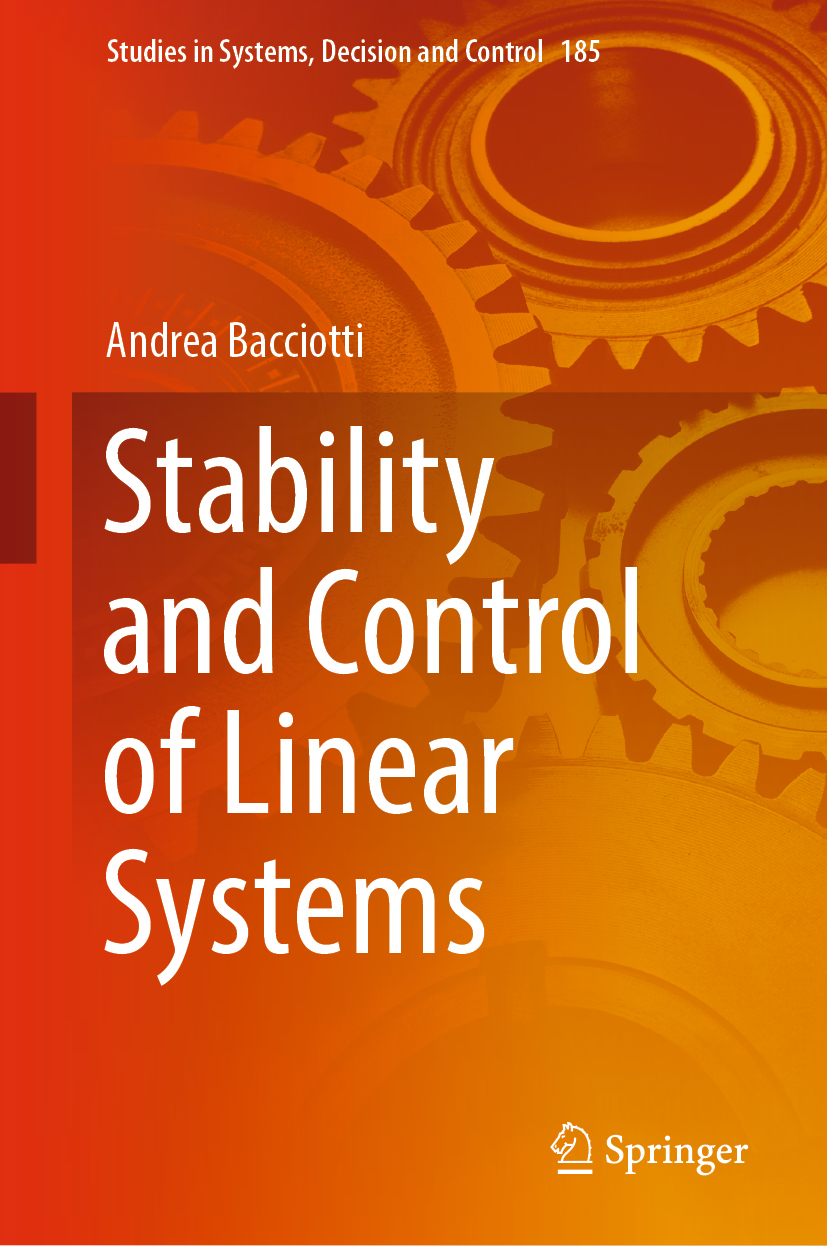
The series Studies in Systems, Decision and Control (SSDC) covers both new developments and advances, as well as the state of the art, in the various areas of broadly perceived systems, decision making and controlquickly, up to date and with a high quality. The intent is to cover the theory, applications, and perspectives on the state of the art and future developments relevant to systems, decision making, control, complex processes and related areas, as embedded in the fields of engineering, computer science, physics, economics, social and life sciences, as well as the paradigms and methodologies behind them. The series contains monographs, textbooks, lecture notes and edited volumes in systems, decision making and control spanning the areas of Cyber-Physical Systems, Autonomous Systems, Sensor Networks, Control Systems, Energy Systems, Automotive Systems, Biological Systems, Vehicular Networking and Connected Vehicles, Aerospace Systems, Automation, Manufacturing, Smart Grids, Nonlinear Systems, Power Systems, Robotics, Social Systems, Economic Systems and other. Of particular value to both the contributors and the readership are the short publication timeframe and the world-wide distribution and exposure which enable both a wide and rapid dissemination of research output.
More information about this series at http://www.springer.com/series/13304

This Springer imprint is published by the registered company Springer Nature Switzerland AG
The registered company address is: Gewerbestrasse 11, 6330 Cham, Switzerland
To Giannina
This book is the natural outcome of a course I taught for many years at the Technical University of Torino, first for students enrolled in the aerospace engineering curriculum, and later for students enrolled in the applied mathematics curriculum. The aim of the course was to provide an introduction to the main notions of system theory and automatic control, with a rigorous theoretical framework and a solid mathematical background.
Throughout the book, the reference model is a finite-dimensional, time-invariant, multivariable linear system. The exposition is basically concerned with the time-domain approach, but also the frequency-domain approach is taken into consideration. In fact, the relationship between the two approaches is discussed, especially for the case of single-inputsingle-output systems. Of course, there are many other excellent handbooks on the same subject (just to quote a few of them, [3, 6, 8, 11, 14, 23, 25, 27, 28, 32]). The distinguishing feature of the present book is the treatment of some specific topics which are rare to find elsewhere at a graduate level. For instance, bounded-inputbounded-output stability (including a characterization in terms of canonical decompositions), static output feedback stabilization (for which a simple criterion in terms of generalized inverse matrices is proposed), controllability under constrained controls.
The mathematical theories of stability and controllability of linear systems are essentially based on linear algebra, and it has reached today a high level of advancement. During the last three decades of the past century, a great effort was done, in order to develop an analogous theory for nonlinear systems, based on differential geometry (see [7] for a historical overview). For this development, usually referred to as geometric control theory , we have today a rich literature ([2, 5, 13, 1820, 26, 30]). However, I believe that the starting point for a successful approach to nonlinear systems is a wide and deep knowledge of the linear case. For this reason, while this book is limited to the linear context, in the presentation and organization of the material, as well as in the selection of topics, the final goal I had in mind is to prepare the reader for such a nonlinear extension.
Concerning the prerequisites, I assume that the reader is familiar with basic differential and integral calculus (for real functions of several real variables) and linear algebra. Some notions of complex analysis are required in the frequency-domain approach. The book can be used as a reference book for basic courses at a doctoral (or also upper undergraduate) level in mathematical control theory and in automatic control. More generally, parts of this book can be used in applied mathematics courses, where an introduction to the point of view of system theory and control philosophy is advisable. The perspective of control systems and the stability problem are indeed ubiquitous in applied sciences and witness a rapidly increasing importance in modern engineering. At a postdoctoral level, this book can be recommended for reading courses both for mathematician oriented to engineering applications and engineers with theoretical interests. To better focus on the main concepts and results, some more technical proofs are avoided or limited to special situations. However, in these cases, appropriate bibliographic references are supplied for the curious reader.
It follows a short description of the contents. The first chapter aims to introduce the reader to the point of view of system theory: In particular, the notions of inputoutput operator and external stability are given. The second chapter deals with systems without external forces which reduce, according to a more classical terminology, to homogeneous systems of linear differential equations. In view of the application, we are interested in, the representation of the general integral in terms of exponential matrix and Jordan form is crucial, and it is treated in detail. Chapter , we introduce the frequency-domain approach and study the relationship with the time-domain approach. Two appendices follow. In the first one, the notions of internal stability are introduced. These notions are formulated with respect to a system of nonlinear ordinary differential equations. In fact, only in this part of the book nonlinear systems came into play. The reason of this choice is that all the aspects of the stability notions became more evident in the nonlinear context. The second appendix is a short list of useful facts about Laplace transform.
Font size:
Interval:
Bookmark:
Similar books «Stability and Control of Linear Systems»
Look at similar books to Stability and Control of Linear Systems. We have selected literature similar in name and meaning in the hope of providing readers with more options to find new, interesting, not yet read works.
Discussion, reviews of the book Stability and Control of Linear Systems and just readers' own opinions. Leave your comments, write what you think about the work, its meaning or the main characters. Specify what exactly you liked and what you didn't like, and why you think so.

